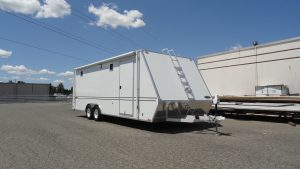 Manufacturing a tagalong trailer seems like a simple task. All you have to do is build a box, weld on a coupler, bolt on some axles and down the road you go. Well unfortunately it’s not that easy. Tagalong trailers posses some very peculiar characteristics. The main problem exists between the carrying capacity and towability of the trailer. Most trailer manufactures place their axles close to the middle of their trailers. These companies originally came from the livestock, cargo or the RV industry so little attention was paid to the handling or performance of their trailers. You can always recognize these tagalongs quite easily. Just look for the trailers that are whipping from side to side and the driver has a death grip on the steering wheel. Ha! The problem exists because the axles are located to far forward. The axles do nothing more that hold the trailer off the ground. The same problem would exist if you put the tail of an airplane in the center of the fuselage, or placed the rudder of a boat into the center of the hull. We have solved this problem by calculating our own specific axle set back for each TPD trailer. TPD’s axle setup provides the optimum in cargo handling without sacrificing performance. TPD has spent years developing new and innovative designs into every tagalong that we manufacture. Our designs have helped to propel us into the forefront of trailer technology.
Manufacturing a tagalong trailer seems like a simple task. All you have to do is build a box, weld on a coupler, bolt on some axles and down the road you go. Well unfortunately it’s not that easy. Tagalong trailers posses some very peculiar characteristics. The main problem exists between the carrying capacity and towability of the trailer. Most trailer manufactures place their axles close to the middle of their trailers. These companies originally came from the livestock, cargo or the RV industry so little attention was paid to the handling or performance of their trailers. You can always recognize these tagalongs quite easily. Just look for the trailers that are whipping from side to side and the driver has a death grip on the steering wheel. Ha! The problem exists because the axles are located to far forward. The axles do nothing more that hold the trailer off the ground. The same problem would exist if you put the tail of an airplane in the center of the fuselage, or placed the rudder of a boat into the center of the hull. We have solved this problem by calculating our own specific axle set back for each TPD trailer. TPD’s axle setup provides the optimum in cargo handling without sacrificing performance. TPD has spent years developing new and innovative designs into every tagalong that we manufacture. Our designs have helped to propel us into the forefront of trailer technology.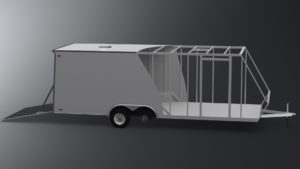 Our design is actually very simple. We start out by re-positioning the main chassis members to the outside edge of the trailer. Next we place the entire upper wall structure directly on top of the main chassis section. The walls and roof studs are then welded in place. The combination of joining the walls directly to the chassis provides superior strength unmatched by any other trailer manufacturer.
Our design is actually very simple. We start out by re-positioning the main chassis members to the outside edge of the trailer. Next we place the entire upper wall structure directly on top of the main chassis section. The walls and roof studs are then welded in place. The combination of joining the walls directly to the chassis provides superior strength unmatched by any other trailer manufacturer.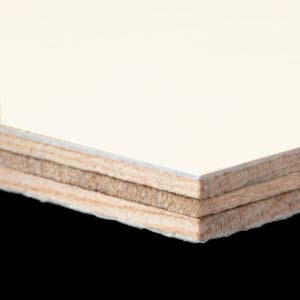 In the center of every composite panel is a very special plywood core. These plywood sheets are butt jointed and stapled together to form a panel that is 8’ high and 48’ long. Next a clear sheet of plastic which has been sprayed with a bright white gel coat finish is laid out on a specially heated vacuum table. A mixture fiberglass resin is poured over the gel coat finish. Then a single one-piece length of woven roving polyester material is laid out and placed over the resin. The Plywood panel is then lifted and placed on top of the woven material. Now the procedure is reversed! First the woven roving material is laid on top of the plywood. The fiberglass resin is poured over woven roving material. Another sheet of clear plastic with the gel coat finish is placed on top of the resin. The sides of the plastic sheets are tapped together to make an airtight bag. A vacuum tube is stuck into the sealed bag to suck out all the air. At this point the top lid of the table is set down on the bag like a big waffle iron. The table is heated along with 3 atmospheres of pressure that compresses the all the resin into the seams of the plywood. 20 minutes later out pops a one piece; 8’x 48’ seamless composite panel that’s ready to go. Whew! Was that a mouth full or what?
In the center of every composite panel is a very special plywood core. These plywood sheets are butt jointed and stapled together to form a panel that is 8’ high and 48’ long. Next a clear sheet of plastic which has been sprayed with a bright white gel coat finish is laid out on a specially heated vacuum table. A mixture fiberglass resin is poured over the gel coat finish. Then a single one-piece length of woven roving polyester material is laid out and placed over the resin. The Plywood panel is then lifted and placed on top of the woven material. Now the procedure is reversed! First the woven roving material is laid on top of the plywood. The fiberglass resin is poured over woven roving material. Another sheet of clear plastic with the gel coat finish is placed on top of the resin. The sides of the plastic sheets are tapped together to make an airtight bag. A vacuum tube is stuck into the sealed bag to suck out all the air. At this point the top lid of the table is set down on the bag like a big waffle iron. The table is heated along with 3 atmospheres of pressure that compresses the all the resin into the seams of the plywood. 20 minutes later out pops a one piece; 8’x 48’ seamless composite panel that’s ready to go. Whew! Was that a mouth full or what?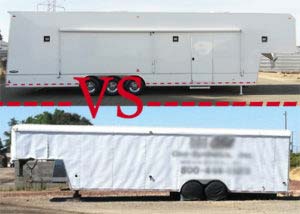 Did you know that a composite panel is 5 times stronger then it’s plywood core. This is achieved by the lamination of composite materials to both sides of the plywood. For example take a piece of 1/4” composite panel, lay it down flat like a playing card, now try to bend it in the middle. You will find it almost impossible to bend. Why? Because when you try to bend the panel you are attempting to stretch the top laminate and compress the bottom laminate. In the world of physics this is called opposing forces. Now imagine how much stronger it is when we stand the composite panel up on its edge attaching it to our Perimeter Chassis! TPD Composite Trailers have a far superior strength to weight ratio over any other aluminum trailer manufactured today, bar none! You could literally flip our trailers upside down on their roofs and it would still be as strong as if it were sitting upright. Unlike aluminum, Composite trailers reflect heat away. On a hot day walk into a Composite trailer and then walk into an aluminum trailer, you will find the composite trailer to be much cooler inside. Our Gel Coat finish is worlds above any painted surface for strength and durability. Chemicals like gasoline, hydraulic oil even lacquer thinner will not harm the Gel Coat finish. Moisture is not a problem either! You can literally use a little soap, water and mop to clean out the interior of a composite trailer!
Did you know that a composite panel is 5 times stronger then it’s plywood core. This is achieved by the lamination of composite materials to both sides of the plywood. For example take a piece of 1/4” composite panel, lay it down flat like a playing card, now try to bend it in the middle. You will find it almost impossible to bend. Why? Because when you try to bend the panel you are attempting to stretch the top laminate and compress the bottom laminate. In the world of physics this is called opposing forces. Now imagine how much stronger it is when we stand the composite panel up on its edge attaching it to our Perimeter Chassis! TPD Composite Trailers have a far superior strength to weight ratio over any other aluminum trailer manufactured today, bar none! You could literally flip our trailers upside down on their roofs and it would still be as strong as if it were sitting upright. Unlike aluminum, Composite trailers reflect heat away. On a hot day walk into a Composite trailer and then walk into an aluminum trailer, you will find the composite trailer to be much cooler inside. Our Gel Coat finish is worlds above any painted surface for strength and durability. Chemicals like gasoline, hydraulic oil even lacquer thinner will not harm the Gel Coat finish. Moisture is not a problem either! You can literally use a little soap, water and mop to clean out the interior of a composite trailer!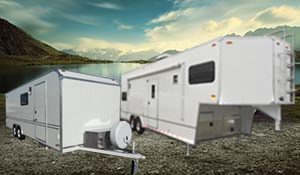 Tagalong trailers carries approximately 90% of their total weight over the axles and distributes the remaining 10% to the rear bumper of the tow vehicle. The turning radius is approximately 45 degrees. The goose neck or 5th wheel trailers carries approximately 75% of their total weight over the axles and distributes the remaining 25% directly over the rear axles of the tow vehicle.
Tagalong trailers carries approximately 90% of their total weight over the axles and distributes the remaining 10% to the rear bumper of the tow vehicle. The turning radius is approximately 45 degrees. The goose neck or 5th wheel trailers carries approximately 75% of their total weight over the axles and distributes the remaining 25% directly over the rear axles of the tow vehicle.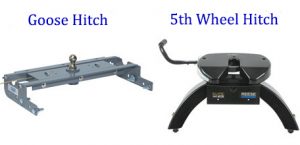 The goose neck trailer got it’s name from the way the hitch drops down like a goose’s neck into the bed of a truck. The goose neck receiver is usually a 2 5/16” hitch ball which is mounted flush to the bed. The 5th wheel usually has a 2” kingpin mounted under the front nose of the trailer. The receiver is mounted above the bed and is called a pedestal. Tagalongs up to 34’ in overall length do a fine job for the majority of our customers. For those customers who need more space and want to haul more cargo the gooseneck is the answer. We start our goose neck line with our 34’ Vision and go to the triple axle setup from 40’ to 48’ feet.
The goose neck trailer got it’s name from the way the hitch drops down like a goose’s neck into the bed of a truck. The goose neck receiver is usually a 2 5/16” hitch ball which is mounted flush to the bed. The 5th wheel usually has a 2” kingpin mounted under the front nose of the trailer. The receiver is mounted above the bed and is called a pedestal. Tagalongs up to 34’ in overall length do a fine job for the majority of our customers. For those customers who need more space and want to haul more cargo the gooseneck is the answer. We start our goose neck line with our 34’ Vision and go to the triple axle setup from 40’ to 48’ feet.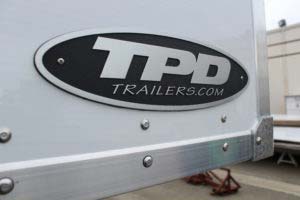 If you decide to purchase a TPD Trailer (and it is not an in-stock unit), these are the basic steps:
If you decide to purchase a TPD Trailer (and it is not an in-stock unit), these are the basic steps:
Decide on the trailer and options.
You pay the down payment, and we assign a production slot for the trailer.
Next, we will create a CAD (Computer Assisted Drafting) drawing of your trailer, with the desired options in place.
We will submit the drawing to you for your approval and signature.
At this point you should make any modifications (locations of D-Rings, Spare Tire Mount, etc.). If necessary, we will make the modifications, re-draw the trailer, and re-submit it for your approval.
When you approve the drawing, with no modifications, the trailer will be built when its production slot comes up. A Design Fee will be charged for modifications made after a drawing is approved.
After your TPD Trailer is built and goes through our thorough inspection process it is ready for delivery.


